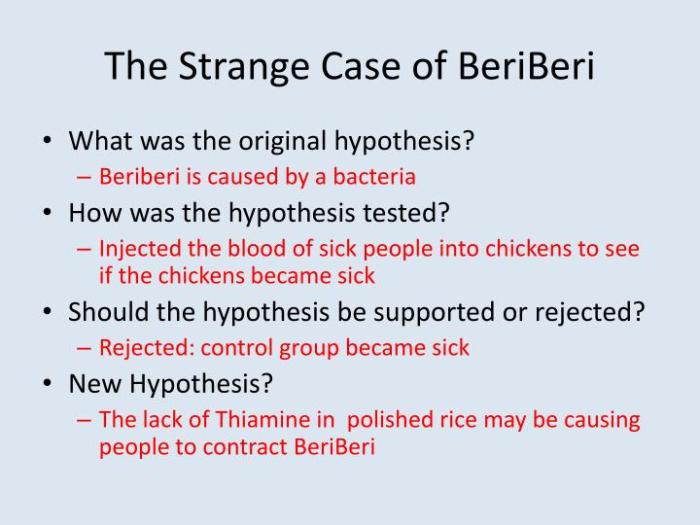The strange case of beriberi answers is an intriguing medical detective story that has captivated scientists and healthcare professionals for centuries. This condition, characterized by a deficiency of thiamine (vitamin B1), has left an indelible mark on history, causing widespread suffering and even death.
Our journey into the strange case of beriberi answers will delve into the complexities of this enigmatic disease, exploring its historical roots, nutritional implications, diagnostic challenges, and therapeutic interventions. Along the way, we will uncover the fascinating stories and breakthroughs that have shaped our understanding of beriberi.
Etiology of Beriberi
Beriberi, a disease characterized by neurological and cardiovascular symptoms, is caused by a deficiency of thiamine (vitamin B1). Thiamine plays a crucial role in energy metabolism and nerve function. When the body lacks sufficient thiamine, it can lead to a cascade of physiological abnormalities.
There are two main forms of beriberi: wet beriberi and dry beriberi. Wet beriberi affects the cardiovascular system, causing symptoms such as edema, shortness of breath, and an enlarged heart. Dry beriberi, on the other hand, affects the nervous system, leading to symptoms such as numbness, tingling, and muscle weakness.
Populations at risk for beriberi include individuals who consume diets low in thiamine, such as those who rely heavily on polished rice as a staple food. Alcoholism, chronic diarrhea, and other conditions that impair thiamine absorption can also increase the risk of beriberi.
Historical Context of Beriberi

The history of beriberi dates back centuries, with early descriptions of the disease appearing in Chinese medical texts. In the 19th century, beriberi became a significant health concern in Japan, where it was prevalent among the military and prison populations.
The Japanese physician Takaki Kanehiro made groundbreaking contributions to understanding beriberi, demonstrating that it was caused by dietary factors rather than infectious agents.
In the early 20th century, the Dutch physician Christiaan Eijkman conducted experiments on chickens, demonstrating that a lack of a specific substance in rice bran caused beriberi-like symptoms. This discovery led to the identification of thiamine as the essential nutrient responsible for preventing beriberi.
Nutritional Implications of Beriberi

Thiamine is an essential nutrient involved in various bodily functions, including energy metabolism, nerve function, and heart health. It is primarily obtained through the consumption of whole grains, legumes, nuts, and meat.
A diet rich in thiamine includes foods such as:
- Brown rice
- Whole-wheat bread
- Oatmeal
- Beans
- Lentils
- Nuts
- Meat
The recommended daily intake of thiamine varies depending on age and sex, but generally ranges from 1.1 to 1.5 mg per day.
Diagnostic and Therapeutic Approaches to Beriberi
The diagnosis of beriberi is based on clinical symptoms and a history of thiamine deficiency. Laboratory tests, such as measuring thiamine levels in the blood or urine, can confirm the diagnosis.
Treatment for beriberi involves administering thiamine supplements. The type and dosage of thiamine will depend on the severity of the deficiency. In severe cases, intravenous thiamine may be necessary. Other supportive measures, such as electrolyte replacement and cardiac monitoring, may also be required.
Prevention and Control of Beriberi

Preventing and controlling beriberi at the community level involves public health measures aimed at improving nutrition and reducing thiamine deficiency.
Key strategies for preventing and controlling beriberi include:
- Promoting the consumption of thiamine-rich foods
- Fortifying staple foods, such as rice and flour, with thiamine
- Providing thiamine supplements to at-risk populations
- Educating the public about the importance of thiamine and the prevention of beriberi
Case Study: Investigating an Outbreak of Beriberi
In a hypothetical scenario, an outbreak of beriberi occurs in a remote village where polished rice is the primary staple food. To investigate the outbreak, a step-by-step approach is employed:
- Data collection:Gather information on the affected individuals, including their symptoms, dietary habits, and medical history.
- Analysis:Review the data to identify commonalities among the cases and potential risk factors.
- Hypothesis:Formulate a hypothesis regarding the cause of the outbreak, based on the analysis of the data.
- Further investigation:Conduct additional investigations, such as food samples testing, to confirm the hypothesis.
- Control measures:Implement measures to control the outbreak, such as distributing thiamine supplements and promoting the consumption of thiamine-rich foods.
FAQ Explained: The Strange Case Of Beriberi Answers
What is the main cause of beriberi?
The main cause of beriberi is a deficiency of thiamine (vitamin B1).
What are the different types of beriberi?
There are two main types of beriberi: wet beriberi and dry beriberi. Wet beriberi affects the cardiovascular system, while dry beriberi affects the nervous system.
How is beriberi diagnosed?
Beriberi is diagnosed based on a combination of symptoms, physical examination findings, and laboratory tests.